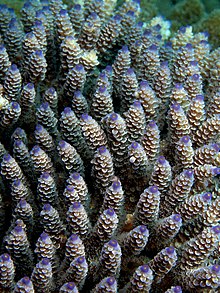Acroporidae
| Acroporidae Temporal range:
| |
|---|---|

| |
| Acropora secale, the corallites can be seen at the end of the branches. | |
| Scientific classification | |
| Domain: | Eukaryota |
| Kingdom: | Animalia |
| Phylum: | Cnidaria |
| Class: | Hexacorallia |
| Order: | Scleractinia |
| Suborder: | Astrocoeiina |
| Family: | Acroporidae Verrill, 1902[2] |
| Genera[2] | |
Acroporidae is a family of small polyped stony corals in the phylum Cnidaria. The name is derived from the Greek "akron" meaning "summit" and refers to the presence of a corallite at the tip of each branch of coral.[3] They are commonly known as staghorn corals and are grown in aquaria by reef hobbyists.[4]
Description
Staghorn corals are the dominant group of
Distribution
Anacropora, Astreopora and Montipora are found in the Indian and Pacific Ocean. Acropora is cosmopolitan and is both common and conspicuous, usually being dominant in Indo-Pacific reefs.[3] Enigmopora is represented by a single new species, Enigmopora darveliensis,[5] found in Malaysia and the Philippines.[6]
Biology
Staghorn corals are hermaphrodites. They are mostly broadcast-spawners and some species have been involved in annual synchronous mass-spawning events on the Great Barrier Reef and in Japanese and Indonesian waters. Some species undergo fragmentation, a form of asexual reproduction, and this sometimes results in reefs composed of a single species.[3]
References
- ISSN 0722-4028.
- ^ a b Hoeksema, B. (2013). "Acroporidae". WoRMS. World Register of Marine Species. Retrieved April 16, 2014.
- ^ a b c d "Classification of Scleractinian (Stony) Corals". Archived from the original on 2011-12-06. Retrieved 2011-05-23.
- ^ a b Quintessential Small Polyped Stony Corals, the Staghorns, Family Acroporidae
- ^ van der Land, Jacob (2010). "Enigmopora". WoRMS. World Register of Marine Species. Retrieved 2012-01-20.
- . Retrieved 12 November 2021.
